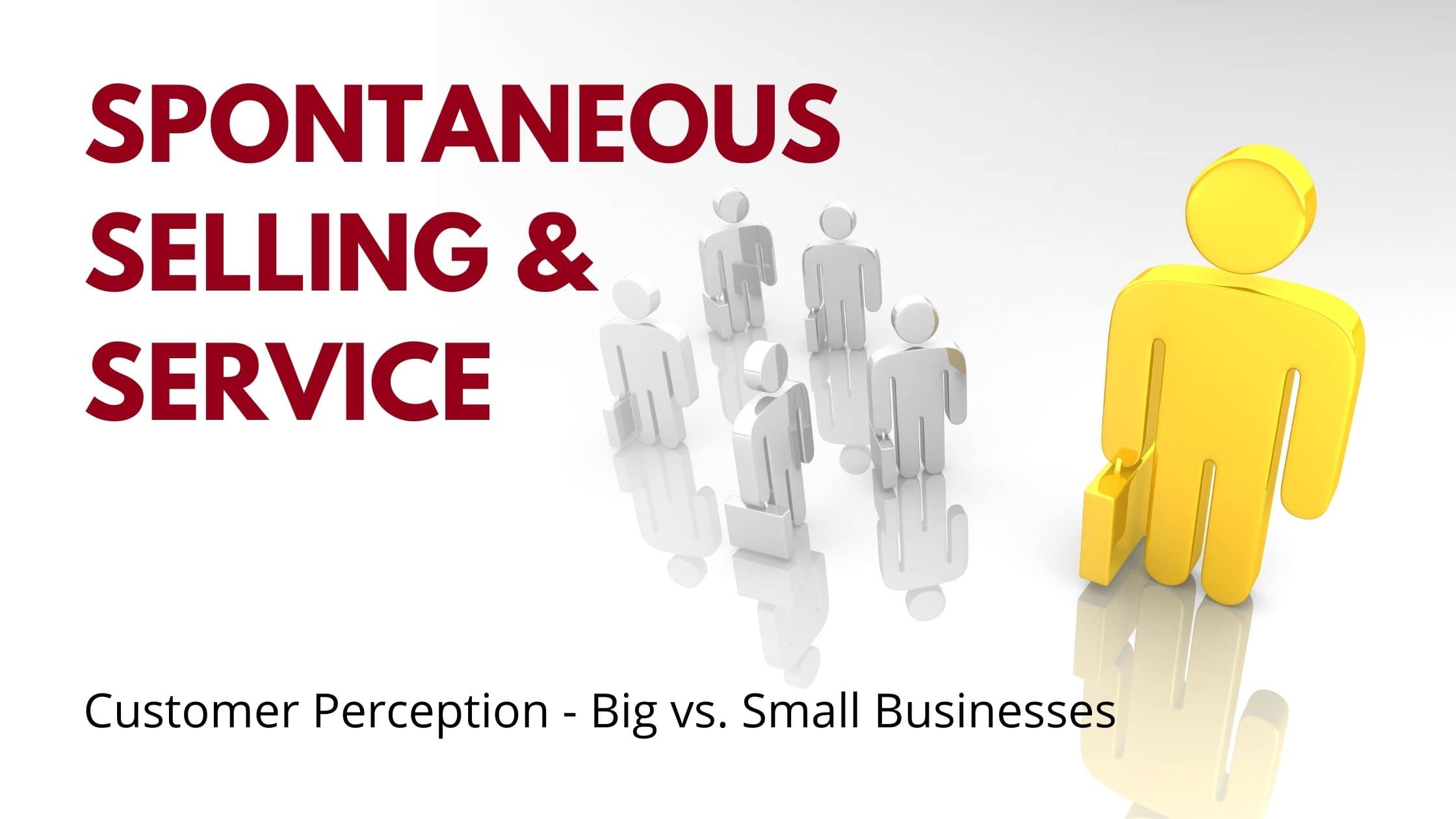This article about customer perception is part of series by Gina Trimarco called Spontaneous Selling & Service, focusing on real sales and customer service situations that needed some off-the-script spontaneity tactics to ensure recovery, retention and referrals.
Whether your business is big or small, internationally known or only known to the locals, your customer’s perception of how they are treated is their reality. In business this perception refers to your customers’ awareness, their impressions, and their opinions about your business, products, and brand. And the bigger the business, the bigger the expectations for a positive customer experience. If you want to stand out, delight the customer with behavior that disrupts negative bias.
It was a holiday weekend in the tourist destination in which I live. Going to a restaurant in these parts can be a challenge even if it weren’t a nationally-celebrated three day weekend. Throw in covid and the understaffed epidemic and it’s been almost impossible to enjoy a meal outside the comfort of your own home. Long wait times are to be expected and slow service is the new staple. As a local, if you choose to go out for a meal, you choose to wait AND be patient.
My friend wanted to go to Cracker Barrel for breakfast. Not my favorite but there’s something to be said about knowing what to expect. The food, while always a various shade of beige, is consistent but so are their long lines. Upon arrival the parking lot looked okay. Plenty of spaces available: a good sign if you’re looking to have a quick meal. No line at the hostess stand either. In retrospect, the general public apparently knew something we didn’t.
We asked for a table for two and the hostess took us to a small table, passing a couple dirty ones along the way. My friends frustration was palpable, he hates a small table. Some people hate getting stuck in traffic, others can’t stand pistachios that won’t open, this guy hates small tables. Too each their own. Before the hostess could even put the menus down, my friend speaks up asking for a larger table. He might as well of asked our hostess for her kidney because she stopped dead in her tracks. Clearly not prepared for such a simple request she blurts out “YOU’LL HAVE TO GO BACK TO THE HOSTESS STAND AND WAIT.”
Obviously that could’ve been handled better but then my friend muttered under his breath “Let’s go, I don’t want to stay.” You get an emotional reaction! And you get an emotional reaction! Everyone gets an emotional reaction! What? You’ve never seen Oprah’s Favorite Things episodes?
Anyway, I too can easily get stirred over poor customer service but I was little more rational in this moment and suggested we see what she comes up with. In that moment it made more sense to me to wait it out than waste time driving to a different restaurant. We walked back to the stand as instructed and watched as the hostess discussed the whole ‘debacle’ with another hostess. The second hostess quickly asked if we were leaving, it’s obvious my friend wanted to bolt. I told her no and asked how long the wait would be. Let it be noted that there was no one in line for a table and a majority of the tables were empty. Her response, “It’ll be 10 minutes.”
My amygdala kicked in immediately. I turned to my friend, “let’s go.”
Recap: Bad Perception – Bad Reality
Before we move on to the next restaurant however, let’s just recap our experience, our ‘perception’; in other words the restaurant’s “reality”:
The restaurant was empty and slow, being seated quickly shouldn’t have been such an issue. While there were a number of tables were marked as “closed due to covid” we’d also had many restaurant experiences where this was no longer an issue. I think we’re all experiencing Covid-19 fatigue and tired of covid-based excuses. Before we even walked in the door there was an expectation for a specific experience based on first impressions, branding, past experiences, etc. None of which were met. Our perception, their reality turned out to be less than great.
The Remedy: Changing their perception
This situation could’ve been easily corrected if the hostess had the necessary skills to control her emotions and reactions in that moment. A simple phrase such as “I’d be happy to seat you somewhere else. If you don’t mind waiting at the hostess stand, I’ll get that table cleaned off right away.” Even if she didn’t have a table available, she would’ve bought herself some time with that response. Our monkey brains wouldn’t have gotten the best of us.
The other thing she SHOULD have done was to be prepared for customer’s objection. As sales people, we know that we should anticipate objections and resistance from customers. These two things would’ve drastically changed our perception.
I grew up in the restaurant business and started as a hostess. I quickly learned how to read all types of customers (senior citizens, families, dating couples, etc) and to anticipate their requests, such as preferring a booth over a table or a table by the window. Before seating anyone, I always had “Plan B” in case things went awry. I understood the need to do what was best for the business, such as “rotating the server’s stations” to ensure every employee was treated fairly, especially because the wrath of a server can get ugly. My job was to give the customer an exceptional experience.
This sounds all well and good, right? But you’re wondering ‘HOW does a hostess (or anyone for that matter) acquire these skills?’ Of course, some people are just wired for being exceptional humans. For the rest of us common folk, training is definitely the solution. However, that training has to include emotional intelligence and improvisational skills, not just the customer service basics. We must get better at responding appropriately in the moment, acting beyond the script and SOP (standard operating procedure).
Creating an exceptional experience is what differentiates your business from the many businesses that do exactly what you do. This differentiation will make you “business of choice”.
On To The Next Restaurant (The Competition)
Still hungry, we drove to a local, family-owned restaurant. Upon arrival, there was NOWHERE to park. We had to make a parking space in the grass. My fight or flight reaction started to simmer. I thought we’d be waiting forever to get seated and wished we would’ve stuck it out at Cracker Barrel. We just traded one bad experience for another bad experience. On top of that, we were getting hangry. Not a great combination.
All of this flashed in my mind in mere seconds. I was already experiencing negativity bias. My initial perception: BAD.
There were customers everywhere and no real organization when we walked in, but that lasted only seconds before the cashier said someone would be right with us and then a hostess appeared. She didn’t even ask “how many?”. She had menus in hand, said “Right this way” and seated us in a big comfy booth.
My brain was still prepared for the worst as I noticed that almost every table was taken. They were slammed. BUT our server approached us within the textbook required two minutes, got our beverage order AND was happy to serve us. From start to finish the entire experience was over in less than an hour. We had exceptional service and they “turned the table” over quickly to generate more revenue.
I was wrong.
I assumed the worst would happen but this was a small business with a big experience that drives their business to success.
The Differences …
Comparing the two restaurants and the different experiences:
I wonder if Cracker Barrel fell victim to following the early day “rules” of covid to “be safe”, instead of adapting to mask and occupancy requirements being lifted in my state. That definitely plays a role because I can only assume that the employees have been trained to stick to the guidelines from the corporate office.
In any case, train your employees to tell customers what you CAN do for them, not what you CAN’T do. Now more than ever, employees need soft skills training to interact and engage with customers who NEVER want to hear about policies and regulations, like ever, regardless of covid.
At the local restaurant, a family-owned business, it was most likely easier for them to pivot and do what made the most sense for their business, customers and employees. A small business doing big business is going to be one with grit, resilience and determination to thrive. The owners are in the trenches and understand the needs of all stakeholders involved. As a company grows, it needs to remember to maintain its grit and agility.
Most importantly, an exceptional customer experience is the tipping point and a game changer for success. Make their perception a positive one to guarantee a positive reality for yourself.




